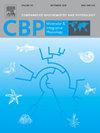The histological and molecular response of acute hypoxia and reoxygenation in rainbow trout and steelhead
IF 2.2
3区 生物学
Q4 BIOCHEMISTRY & MOLECULAR BIOLOGY
Comparative Biochemistry and Physiology A-Molecular & Integrative Physiology
Pub Date : 2025-04-02
DOI:10.1016/j.cbpa.2025.111854
引用次数: 0
Abstract
Hypoxia is a critical environmental stressor affecting fish survival and physiological function. Landlocked rainbow trout (Oncorhynchus mykiss) and anadromous steelhead (Oncorhynchus mykiss), two ecotypes of the same species, exhibit distinct physiological adaptations to fluctuating oxygen levels. To investigate their responses to acute hypoxia in these fish, brain histology and transcriptome analyses were conducted before stress, after hypoxia (12 and 24 h), and after reoxygenation (24 h). The results showed that the number of vacuolated nerve cells in the brain increased with the duration of hypoxia and decreased after 24 h of reoxygenation in both fish. RNA-Seq analysis identified 8409 differentially expressed genes (3952 in rainbow trout and 4457 in steelhead), one hypoxia-related module (MEred), and two significantly expressed gene clusters (cluster 3 in rainbow trout and cluster 8 in steelhead) through differential expression analysis, weighted gene co-expression network analysis (WGCNA), and Mfuzz clustering. KEGG pathway enrichment analysis revealed that signal transduction, immune response, angiogenesis, and apoptosis were significantly influenced by hypoxia in both fish. Distinct hypoxic responses were observed: in rainbow trout, ferroptosis, necroptosis, phosphatidylinositol signaling, calcium, and apelin signaling pathways were enriched, whereas in steelhead, the enriched pathways included platelet activation, Rap1, PI3K-Akt, Hippo, relaxin, and oxytocin signaling. Steelhead display marginally greater hypoxia tolerance than rainbow trout, although the difference is minimal, likely owing to their classification as the same species. These findings provide insight into the physiological and molecular mechanisms underlying hypoxia and reoxygenation stress in salmonids, contributing to a broader understanding of oxygen homeostasis in fish.

虹鳟鱼和虹鳟急性缺氧和再氧合的组织学和分子反应。
缺氧是影响鱼类生存和生理功能的重要环境应激源。内陆虹鳟(Oncorhynchus mykiss)和溯河steelhead (Oncorhynchus mykiss)是同一物种的两种生态型,对波动的氧气水平表现出不同的生理适应。为了研究这些鱼对急性缺氧的反应,在应激前、缺氧后(12和24 h)和再氧化后(24 h)进行了脑组织组织学和转录组分析。结果表明,两鱼脑内空泡神经细胞的数量随缺氧时间的延长而增加,再氧24 h后减少。RNA-Seq分析通过差异表达分析、加权基因共表达网络分析(WGCNA)和Mfuzz聚类,鉴定出8409个差异表达基因(虹鳟鱼3952个,钢头4457个)、1个缺氧相关模块(MEred)和2个显著表达基因簇(虹鳟鱼簇3和钢头簇8)。KEGG通路富集分析显示,缺氧对两种鱼的信号转导、免疫应答、血管生成和细胞凋亡均有显著影响。观察到不同的缺氧反应:虹鳟中,铁下垂、坏死下垂、磷脂酰肌醇信号通路、钙和apelin信号通路富集,而在虹鳟中,血小板活化、Rap1、PI3K-Akt、Hippo、松弛素和催产素信号通路富集。钢头鱼比虹鳟表现出稍强的耐缺氧能力,尽管差异很小,可能是由于它们被归为同一物种。这些发现提供了对鲑鱼缺氧和再氧化应激的生理和分子机制的深入了解,有助于更广泛地了解鱼类的氧稳态。
本文章由计算机程序翻译,如有差异,请以英文原文为准。
求助全文
约1分钟内获得全文
求助全文
来源期刊
CiteScore
5.00
自引率
4.30%
发文量
155
审稿时长
3 months
期刊介绍:
Part A: Molecular & Integrative Physiology of Comparative Biochemistry and Physiology. This journal covers molecular, cellular, integrative, and ecological physiology. Topics include bioenergetics, circulation, development, excretion, ion regulation, endocrinology, neurobiology, nutrition, respiration, and thermal biology. Study on regulatory mechanisms at any level of organization such as signal transduction and cellular interaction and control of behavior are also published.

 求助内容:
求助内容: 应助结果提醒方式:
应助结果提醒方式:


